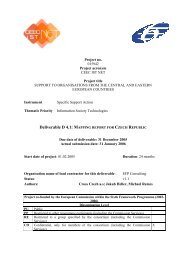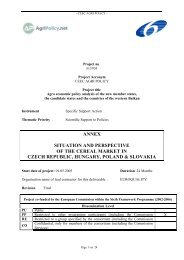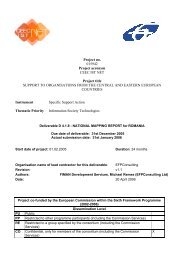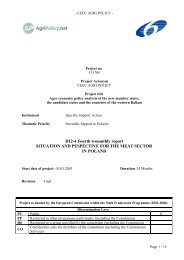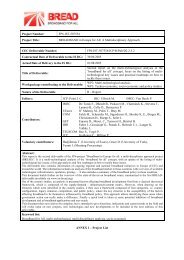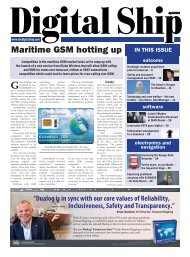Project Number: FP6-IST-507554 Project Title: BROADBAND in ...
Project Number: FP6-IST-507554 Project Title: BROADBAND in ...
Project Number: FP6-IST-507554 Project Title: BROADBAND in ...
You also want an ePaper? Increase the reach of your titles
YUMPU automatically turns print PDFs into web optimized ePapers that Google loves.
6. ICT convergence<br />
Page 16 of 319<br />
<strong>FP6</strong>-<strong>IST</strong>-<strong>507554</strong>/JCP/R/Pub/D2.2-3.2<br />
Convergence is a key concept <strong>in</strong> development of a broadband <strong>in</strong>frastructure. Broadband networks become more<br />
economic viable, if the same network can be used for a wide range of purposes and thereby replace a number of<br />
different networks. In addition a broadband <strong>in</strong>frastructure may be based on an exist<strong>in</strong>g dedicated network<br />
<strong>in</strong>frastructure, e.g. a cable TV network, which is upgraded to support other types of broadband services as well.<br />
On the other hand the availability of broadband access for a substantial number of customers will promote<br />
development of converg<strong>in</strong>g services. For <strong>in</strong>stance depends <strong>in</strong>teractive Internet TV on Internet connections with<br />
sufficient capacity to support on-l<strong>in</strong>e transmission of live pictures.<br />
Convergence is not only a technical challenge, but <strong>in</strong>volves technical as well as market and regulatory issues,<br />
which has to be addressed <strong>in</strong> order to facilitate the objective of broadband for all. Thus convergence <strong>in</strong>cludes at<br />
least five different dimensions:<br />
• Convergence of services – the same content are supplied at different platforms<br />
• Convergence of networks – different services supplied via the same network<br />
• Convergence of term<strong>in</strong>als – multifunctional term<strong>in</strong>als that can support different services (that might be<br />
supplied through different networks)<br />
• Convergence of markets – the same companies supply their products and services <strong>in</strong> different sectors<br />
• Convergence of regulation – the same regulator and the same set of rules apply <strong>in</strong> different sectors.<br />
These dimensions <strong>in</strong>clude both technical and economic aspects as well as regulatory aspects. The technical<br />
development is often seen as the driv<strong>in</strong>g force enabl<strong>in</strong>g convergence. Although the technology is important this<br />
is not entirely true. It was possible to supply the same content at different platforms before the digitalisation, but<br />
the technology developments has made this a lot easier. In many countries (e.g. <strong>in</strong> the US) broadcast and<br />
telecommunication have been regulated by the same regulatory authority long before convergence of<br />
broadcast<strong>in</strong>g and telecom technologies. On the other hand convergence <strong>in</strong> technologies does not per se lead to<br />
convergence <strong>in</strong> markets and <strong>in</strong> regulation. All of these five aspects of convergence will shape development of<br />
broadband networks and are described more <strong>in</strong> detail below.<br />
6.1 Convergence of services<br />
Convergence <strong>in</strong> services implies that the same content can be reached from different types of technical platforms<br />
(e.g. either through the Internet accessed via the telecom network or through a digital video broadcast (DVB)<br />
service delivered through a broadcast<strong>in</strong>g network). This will lead to <strong>in</strong>creas<strong>in</strong>g competition between different<br />
platforms. Customers may, therefore, face a convergent market for various types of <strong>in</strong>formation services.<br />
Digitalisation of content is one of the major drivers of convergence. In the digital world, the same content can be<br />
transmitted across different networks, and different services can be offered based on the same content. The<br />
synergy achieved goes far beyond the electronic communication forms and <strong>in</strong>cludes among others the pr<strong>in</strong>t<strong>in</strong>g<br />
press. However, <strong>in</strong> this context the most important content services to consider are: Internet based services,<br />
broadcast<strong>in</strong>g services and mobile content services.<br />
Capacity-per-user problems and problems associated with return paths <strong>in</strong> broadcast<strong>in</strong>g networks will <strong>in</strong>fluence<br />
the development of data services that will be available <strong>in</strong> the broadcast<strong>in</strong>g networks. Examples of <strong>in</strong>teractive<br />
services offered <strong>in</strong> broadcast<strong>in</strong>g networks without us<strong>in</strong>g a return path <strong>in</strong>clude:<br />
• Download of software: The broadcast<strong>in</strong>g networks are mostly used <strong>in</strong> the daytime and even<strong>in</strong>g hours.<br />
The transmission capacity dur<strong>in</strong>g the night-time can be used to download, e.g., new versions of<br />
software to set-top boxes.<br />
• Download of newspapers: In a similar way, newspapers can be downloaded to set-top boxes.<br />
• Internet on TV: Access to the Internet <strong>in</strong> current TV communication networks is not possible because<br />
of capacity-per-user problems of digital TV networks. A partial solution can be to broadcast a limited<br />
version of Internet.<br />
TV and radio services offered on the Internet are examples of broadcast<strong>in</strong>g services provided on the Internet.<br />
Such services are often tak<strong>in</strong>g the advantage of the <strong>in</strong>teractive facilities of the Internet to provide access to<br />
archived radio and TV transmissions and other <strong>in</strong>teractive services.<br />
Mobile content services are develop<strong>in</strong>g along with <strong>in</strong>creased bandwidths for mobile services. Mobile services<br />
can provide the same content as delivered on the Internet or via broadcast<strong>in</strong>g networks – for <strong>in</strong>stance on-l<strong>in</strong>e



